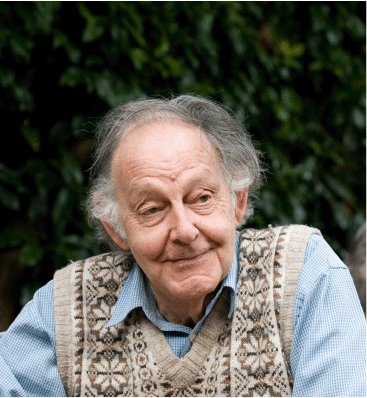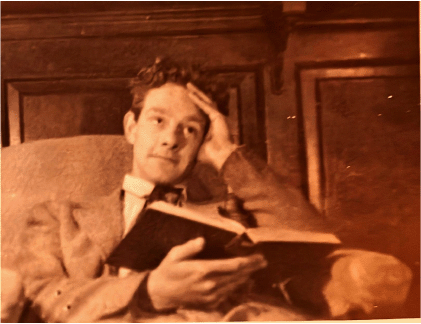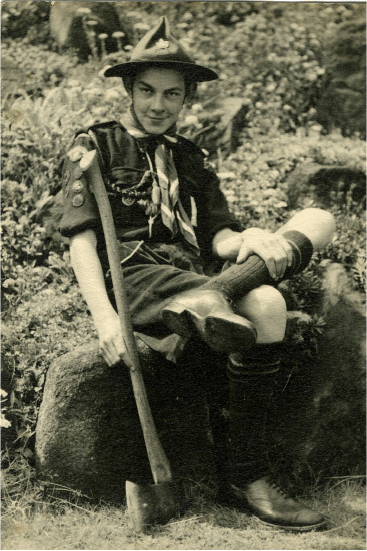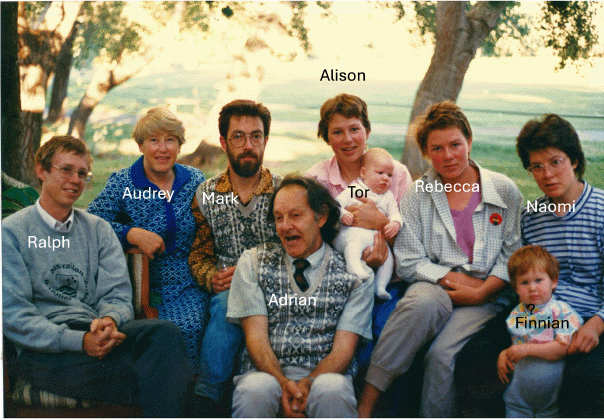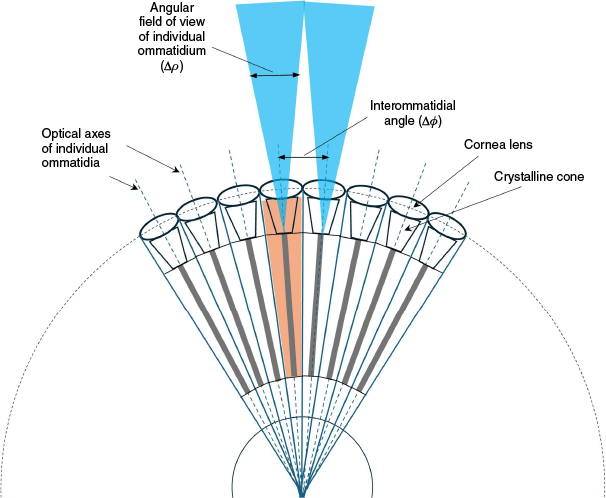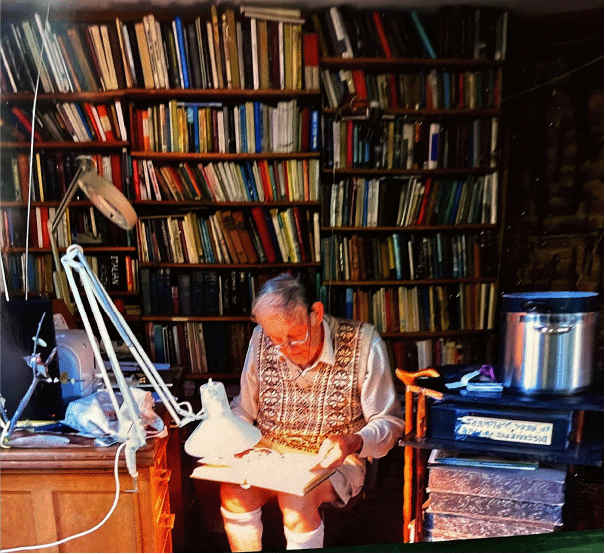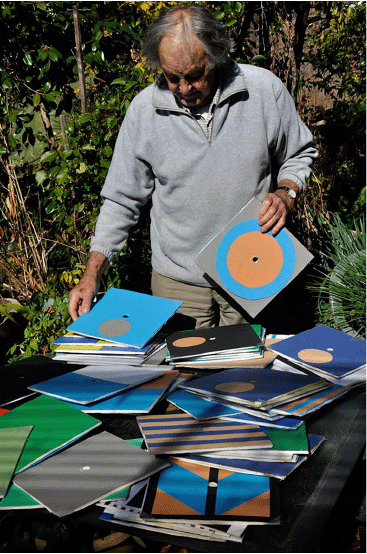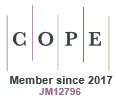George Adrian Horridge (1927–2024)
Mandyam V. Srinivasan A *
A *
A
Abstract
Adrian Horridge is famous for his pioneering studies of invertebrate vision, wherein he used a variety of techniques, including optical analysis of the eyes, electrophysiology of the visual pathways, investigation of behaviour, and development of mathematical models of visual capacity and performance. Born, raised and educated in the United Kingdom, Horridge moved to Australia in the late 1960s to take up a position as a Founding Professor of the Australian National University’s Research School of Biological Sciences. He established a thriving department of neurobiology, which became one of the world’s leading entities in this field. He went on to establish a Centre for Visual Science at the university to foster collaboration across several laboratories on campus. This ultimately led to the establishment of a very successful Australian Centre for Excellence in Vision Science, funded by the Australian Research Council and including participation from other laboratories across Australia, as well from overseas. He was elected to Fellowship of the Royal Society (1969) and the Australian Academy of Science (1971). Horridge continued to study and publish the results of his investigations on insect vision well beyond the date of his official retirement. He has received several awards and honours in recognition of his work. Horridge is also known for his studies in another quite unrelated field—the design of Indonesian sailing craft from antiquity to the twentieth century.
Keywords: behaviour, compound eye, electrophysiology, insect, invertebrate, neurobiology, ommatidium, optics, vision.
Childhood, school and university
George Adrian Horridge1 (Fig. 1) was the only child of George William Horridge, from Lancashire, and Olive Stray, from Sheffield.2 Olive, one of five daughters, was born to a family that ran several sweet shops. Olive married William in 1925 and gave birth to Adrian in December 1927, vowing never to have another son because ‘she nearly died’. While the details remain unknown, the world is very fortunate that both Adrian and his mother survived the birth.
Four generations of Horridges had previously been to King Edward VII School in Sheffield, one of the most prestigious schools in the area. When Adrian first went to that school in 1936 at the age of nine, there were four school masters who remembered his father studying there. All four of them were reputed to be very free with the use of the cane. Adrian excelled at school, and was regularly at the top of his class. He had an encyclopaedic mind with a huge store of knowledge acquired from books at the Sheffield Public Library and the school library. To paraphrase Adrian, his success at school came from ‘rapid and accurate acquisition of knowledge, and a sort of animal ability to avoid danger’2 (including, possibly, the cane!3). Adrian’s younger years, when he was not studying at school, were replete with family picnics and excursions into the countryside. These outings instilled in him a curiosity and interest in nature and the lives of creatures such as crayfish, newts, and water beetles (Fig. 2). His engagement with the outdoors was bolstered by his activities as the leader of his scout patrol (Fig. 3).4
When Adrian was twelve, World War Two broke out and his schooling was interrupted for about two years when classes were run sporadically. He recalled an incident when a British long-range bomber crashed only about one hundred yards away from where he was standing. Adrian was instrumental in providing vital first aid to the crew and summoning medical assistance.
Adrian’s father founded a partnership in a motorcycle business soon after World War One, which led to Adrian’s enduring interest—not only in motorcycles, but in all things mechanical. This played an important role in shaping his research career.
After completing school in 1946, Adrian commenced his university education at Cambridge. He studied four subjects: biochemistry, chemistry, physiology and zoology, and received a First Class Honours in Natural Sciences Tripos in 1950. Adrian initially considered pursuing Chemistry further, but found it to be too ‘cut and dried, technological and factory-based’, and not quite suited to a boy who enjoyed outdoor activities. He therefore opted for a career in the biological sciences. Adrian was drawn to the Department of Zoology, which was full of brilliant scientists at the time, including half-a-dozen Fellows of the Royal Society. Two legendary neuroscientists of the time—Alan Hodgkin and William Rushton—taught him how to use microelectrodes to record the electrical activity of nerve cells.
As a PhD student in Cambridge, Adrian led a spartan existence where he lived and worked in the laboratory. But this circumstance made him a fully engaged researcher, dedicated to the pursuit of science.
This was also around the time when Adrian decided that he needed to find a wife. He came up with a strategy that he considered to be scientific, as well as practical. He purchased two season tickets for the Arts Theatre, one for himself and the other to invite a young lady to attend the evening’s performance with him. After a few unsuccessful attempts, he was able to gain the attention of Audrey Lightburne at a party in Girton College, Cambridge, in 1951. She accepted Adrian’s invitation to the theatre and found the performance—as well as Adrian and his motorcycle—to be very interesting. Audrey was one of four sisters, all of whom went to Girton. Adrian described her as a ‘warm-hearted red-headed third year student of English, daughter of Rev. Harcourt Lightburne, Vicar of Upchurch, Kent’. The pedigree was evidently good! Audrey and Adrian (Fig. 4) were married in 1953, after which Audrey went to Barnett House, Oxford to study for a postgraduate degree in Public Administration. This led her to pursue a career in public service in Britain, as well as after moving to Australia.
Adrian and Audrey during a brief sojourn at Cambridge in later years. Image courtesy of the Horridge family.
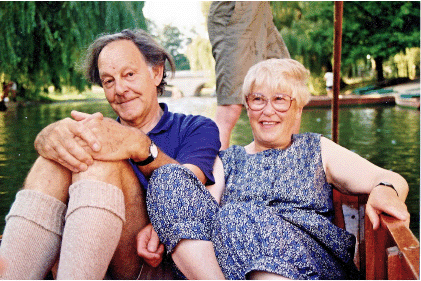
Audrey and Adrian, and their children and grandchildren, were a very close-knit, loving family (Fig. 5). Contrary to what the picture may suggest, Adrian never found their get-togethers boring.
Research achievements
Early work
Adrian’s first paper—published in 1951 as a single-author paper in Nature even before completing his PhD—reported, for the first time, the occurrence of a rare seaweed on the Scilly Isles. This was a purely accidental discovery on a camping trip, a clear sign of his keen interest in observing nature.
During the decade after Adrian received his PhD at Cambridge in 1952, he published fourteen papers dealing with a wide variety of topics investigating the neural basis of behaviour in invertebrates,5 in thirteen of which he was the lead author. These were published while he was at the Gatty Marine Laboratory at the University of St. Andrews in Scotland.
Notable examples of this early research are summarised below.
In 1953 Adrian published a discovery, possibly for the first time, of fibres in the nervous system of jellyfish that transmit electrical action potentials (spikes) in both directions, to co-ordinate the contractions of the muscles that move the tentacles.6
Other major advances were the discovery of the neural basis of the auditory discrimination of pitch (the frequency of sound) in the brain of the locust,7 and a theoretical analysis of how lift is generated by the wings of very small insects.8
Subsequent studies9 investigated the sensitivity of crabs to visual movement and demonstrated that the eyestalks of crabs can track tiny, slow-moving light sources. They can even follow the movement of the sun in a clear sky!
Adrian’s broad scientific curiosity and expertise even extended to the study of photoelasticity, leading him to propose the use of a stress sensitive resin for the design of reinforced plastic structures and for the detection of stress-related cracks. This study10 was conducted when Adrian was a scientific officer with the Royal Aircraft Establishment in Farnborough, in lieu of National Service before he commenced his PhD at Cambridge in neuroscience—a completely different field.
Ten of the first fourteen papers were published in the prestigious journal Nature, and Adrian was the sole author of eight of them. These are testaments to Adrian’s deep and broad intellect that spanned a diverse range of topics, right from the commencement of his scientific career.
One of these early studies11—a textbook example that has inspired many students to pursue a career in neuroscience—is described briefly below.
A headless cockroach can learn! In 1962 Adrian conducted a seminal experiment that demonstrated that learning can be accomplished without a brain—and even in a creature as simple as a cockroach. He decapitated two cockroaches, P and R, and suspended them aloft as shown in Fig. 6.
Demonstration of learning in a headless cockroach. Adapted from fig. 1 of Horridge (1962b) with permission from Nature Springer.

All but one of the six legs were removed from each animal. When cockroaches (or other insects) are suspended in this way, they tend to move their legs up and down randomly. In this experiment the cockroaches were wired up to an electrical stimulator. Cockroach P was suspended such that its rear leg was above a dish of saline. There was no saline dish below cockroach R. The rear legs of P and R were electrically connected in series, as shown in the figure. Whenever P lowered its leg to contact the saline, the circuit was closed and both animals received an electrical shock. The shock caused each animal to raise its leg reflexively. This is an instinctive reaction to avoid a noxious stimulus—rather like the human reaction to withdraw a hand when it accidentally touches a hot pan. It turned out that, after a few shock episodes, P held its leg up permanently, whereas R continued to move its leg up and down randomly. Even though both animals produced this leg-raising reflex every time they received a shock, it was only cockroach P that had the opportunity to associate the electrical shock with the position of its leg. Cockroach R received shocks at random leg positions; therefore, it did not learn this association. This ingenious experiment demonstrated, perhaps for the first time, that a brain is not absolutely essential for learning; learning can be mediated even by simple neural circuits in other parts of the body.
Later work
During 1959–60, when Adrian was a Visiting Associate Professor at the University of California Los Angeles (UCLA) and a Fellow at the Center for Advanced Study in the Behavioral Sciences at Stanford University, he collaborated with Professor Theodore Bullock to produce a 1747-page, two-volume textbook entitled, Structure and Function of the Nervous Systems of Invertebrates, which was published by Freeman press in 1965.12 Bullock described the nervous systems of marine invertebrates (molluscs), and Adrian the nervous systems of terrestrial invertebrates (arthropods), covering developments in the field over nearly a century, and critically describing and summarising work across some 9900 research publications. The book, which was a landmark of its time, became a valuable resource for students of the nervous system. To paraphrase an extract from a review of the book in the journal Science, ‘Readers of this book will forever bless the authors’.13
In the 1960s Adrian built a group at the University of St. Andrews (and later, at the Australian National University) to undertake a comprehensive study of insect vision by examining the optics of their compound eyes, as well as the anatomy and electrophysiology of the photoreceptors and the neurons along the visual pathway that analyse and process visual information to generate meaningful and appropriate behavioural responses.
In the summer of 1967, when Adrian was a Grass Foundation Fellow doing a brief stint studying dragonfly eyes at the Marine Biological Laboratory in Woods Hole, Massachusetts, he received the following telegram from Australia: ‘Considering you seriously for chair stop please visit Canberra our expense stop first week October.’ Adrian went to Canberra and was offered a Chair as Founding Professor of the Research School of Biological Sciences at the Australian National University (ANU). He moved to Canberra with a group of about eight scientists to set up the new laboratory. From here on, Adrian’s work was devoted entirely to the study of insect vision.
Adrian’s work on insect vision—commenced at St. Andrews and continued at the ANU —is summarised in his elegant review article entitled, Insects which turn and look.14 Here he describes how the multifaceted compound eye captures a near-panoramic image of the surrounding world, and illustrates how different insect species possess different eye designs to cater to their particular needs, and to the environment in which they live.
The compound eye of an insect is composed of a large number of individual light sensors, termed ommatidia (Fig. 7). Each ommatidium (an example is shown shaded in orange) captures and senses the light incident from a particular direction of view, through a corneal lens and a crystalline cone (Horridge 1977b). The field of view (Δρ) of each ommatidium is small, typically a few degrees in visual angle. The angle Δϕ between the directions of view of neighbouring ommatidia (the interommatidial angle) is similarly small. Δρ and Δϕ together determine the visual acuity of the compound eye. The smaller their values, the better the capacity of the compound eye to resolve fine detail. Each ommatidium contains photoreceptor cells, typically 6–9 in number. Each photoreceptor carries photopigment in fine tubes, termed microvilli, located in a long thin cylinder termed the rhabdom. Different photoreceptors within the ommatidium carry photopigments that are sensitive to different wavelengths of light, endowing the eye with colour vision. The light incident on each ommatidium is focussed on to the tip of the rhabdom by the corneal lens and the crystalline cone. The rhabdom functions as a light guide, piping the light down the ommatidium, and causing it to be absorbed by the photopigments. When the photopigment in a photoreceptor absorbs light, the photoreceptor generates an electrical potential, which is transmitted to the brain via a network of neurons, leading to the insect’s perception of the visual world surrounding it. In the early 1960s a PhD student, John Scholes, working in Adrian’s laboratory, was probably the first to observe that, in dim light, insect photoreceptors are sensitive enough to produce electrical responses to individually absorbed photons.15
Fig. 8 shows a frontal view of the eyes of a praying mantis. The dark spot in each eye corresponds to the ommatidia that are looking in the direction of the viewer. In these ommatidia the light entering from the direction of the viewer enters the ommatidium and is completely absorbed by the photopigment within it. This results in a non-reflective dark region called the pseudopupil, in pseudo-analogy with the pupil of the human eye. A pseudopupil spanning a large number of ommatidia indicates high visual acuity in this viewing direction, and is analogous to the fovea of the human eye. The foveal region of the compound eye can be easily viewed with a lens or a low-power microscope. The fovea helps the insect inspect potential prey in detail, and possibly determine its distance before launching a predatory attack. Other regions of the compound eye, which look sideways or to the back, are sensitive to movement and alert the insect to items of interest (or threat), causing it to ‘turn and look’. Astonishingly, the miniature compound eyes of insects—measuring just a few millimetres in diameter—endow insects with visual competences akin to those possessed by our own eyes. To paraphrase Adrian, ‘As the compound eyes of insects are adapted to the habits of their owners through an immensely long period of natural selection, these animals wear their visual habits on their eyeballs.’16
Frontal view of the eyes of a praying mantis. Modified from fig. 15 of Horridge (1977a) with permission from Elsevier Press.
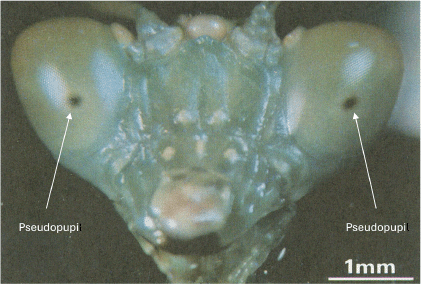
After several years at the ANU, Adrian noticed in the early 1980s that three different laboratories in the university were pursuing various approaches to studying vision and visual processing across a variety of organisms, including humans. These studies were led by Adrian at the Research School of Biological Sciences, Professor Allan Snyder (FAA, FRS) at the Research School of Physical Sciences, and Prof. William Levick (FAA, FRS) at the John Curtin School of Medical Research. Adrian had the vision and foresight to bring these laboratories together under an umbrella termed the Centre for Visual Science. He secured substantial university funding for the centre to appoint many postdoctoral fellows and visiting scientists from across the world, as well as to acquire additional research equipment. This placed the centre on the world map, leading to new collaborations with many national and international laboratories, as well with industry. One example was the development of a novel device to provide a visually-handicapped person with a sense of 3D vision. The device consisted of a hand-held video camera interfaced to a miniature computer. When waved from side to side, the device would provide information, through vibratory signals, about the distances to nearby objects in the environment based on the speed of motion of the images (optic flow) captured by the moving camera, akin to the way in which insects infer the range to obstacles. Another example was a collaboration with Fujitsu (Japan) to produce new hardware for real-time computation of optic flow at high resolution.17
Adrian was the Director of the Centre for Visual Science, and continued to lead it until his official retirement in 1992. The Centre’s reputation motivated Professor Trevor Lamb (FRS) from Cambridge, an expert on vertebrate photoreceptors, to apply, successfully, for a prestigious Federation Fellowship, funded by the Australian Research Council, to work at the John Curtin School of Medical Research. Lamb’s arrival at the ANU bolstered the Centre’s momentum even further, encouraging its participants—spread across Australia as well as internationally—to apply to the Australian Research Council for the creation and funding of an ARC Centre of Excellence for Visual Sciences. This application was successful, leading to a golden era of vision research in Australia, with the funding running from 2006 to 2013, and with Lamb as the Research Director. All of this is clearly due to Adrian’s foresight. Even after his official retirement in 1992, Adrian continued to work from home (Fig. 9), to participate in the new Centre’s activities, and to view and enjoy the success of his efforts.
After Adrian had retired officially and closed his laboratory at the university, he set up a beehive in the backyard of his home. Working on his own, he continued to experiment with honeybees to better understand the mechanisms that underlie their ability to recognise and discriminate visual patterns (Fig. 10). He published several papers on this new work, which also included valuable reflections and insights into many general aspects of vision in honeybees and other insects.18 More recent research from other laboratories,19 using training paradigms that incorporate punishment as well as reward, indicates that the cognitive abilities of honeybees are even better than suggested by Adrian’s studies or others’ earlier studies. This is, of course, characteristic of the way in which scientific knowledge evolves, and does not diminish Adrian’s, or anyone else’s, contribution to the topic.
Investigation of the design of traditional Indonesian sailing boats
Adrian’s curiosity and polymathic talents led him to delve into unanticipated investigations. For example, his book, The Prahu,20 was the first systematic analysis of the unique designs of traditional Indonesian sailing craft that have a history dating back thousands of years, as seen through the eyes of an engineer born and trained in the western world (Fig. 11). Informative photographs and sketches illustrating and explaining the designs of the sails, hulls, and rudders provide novel insights into the skills of early boat builders in Indonesia and among the wider Austronesian seafaring cultures of the Indo-Pacific. This book is the first extensive and authoritative catalogue of the diversity and variety of seacraft—from outrigger dugouts to large sail-trading ships—that were built and used across the vast Indonesian Archipelago. The commentary in the book also highlights the lifestyle and financial and social circumstances of Indonesian fishermen, sailors and traders who relied on these boats for their livelihood. One reviewer of the book says, ‘this compact volume provides the most complete study of indigenous vessels of Indonesia yet undertaken. Undoubtedly, it will remain the definitive study of the Prahu for years to come’.21
Adrian in Makassar Harbour, South Sulawesi, inspecting a Prahu fishing boat in 1979. Photograph taken by Audrey Horridge; image and information provided by Jeffrey Mellefont.
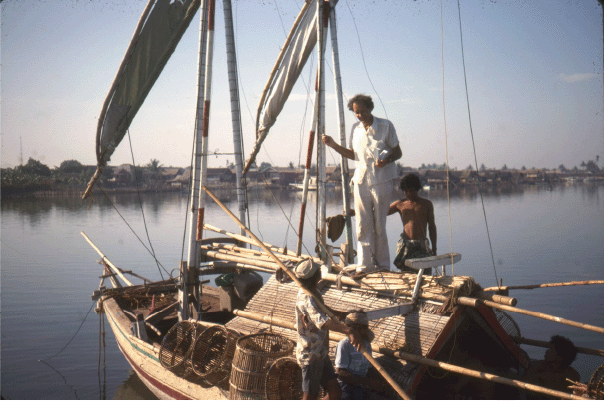
A friend, Jeffrey Mellefont, an Honorary Research Associate at the Australian National Maritime Museum, who has also published on Indonesia’s maritime tradition, has collaborated with Adrian on the study of these boats. Mellefont notes that Adrian’s photographic documentation of these rapidly vanishing boat-building traditions is a unique record, and he has assisted with this archive’s transfer to that museum (Mellefont, personal communication). Approximately 10,000 images were acquired during Adrian’s fifteen visits to Indonesia from 1975 to 1986, spending a total of 47 weeks in the archipelago. Adrian took a crash course in the national language, Bahasa Indonesia, so that he could communicate with the boat builders and sailors.
Fig. 12 shows a small selection of Adrian’s books and monographs on Indonesian boats. Some of them are displayed here and a complete list is available.22
A selection of Adrian’s publications on Indonesian boats. Image courtesy of Jeffrey Mellefont.

Interestingly, Horridge embarked on his study of Indonesian boats purely by chance when he was engaged in research in marine biology aboard the Alpha Helix, a research vessel owned and operated by the Scripps Institution of Oceanography, which made a six-week survey of the remote Banda Sea in Indonesia’s Moluccas province. On his return to Australia, Adrian was able to obtain funding from the Indonesian Institute of Sciences to return to Indonesia several times to study these fascinating boats and publish his descriptions of their design and their history. To paraphrase Mellefont, ‘One should also acknowledge the forbearance of his employer, the Australian National University, since his contract specified research but had neglected to limit it to biology!’.23
Fellowships
Adrian was elected to Fellowship of the Royal Society (FRS) in 1969 and the Australian Academy of Science (FAA) in 1971. He contributed to the Academy over many years and served on the Sectional Committee responsible for Animal Sciences as member from 1989 to 1990 and from 1992 to 1993, and as Chair in 1991. A brief biographical styatement and a list of his career achievements is available in Supplementary Information S2, which accompanies this biographical memoir. A complete list of Adrian’s peer-reviewed publications, as indexed by Scopus, is available in Supplementary Information S3.
Concluding remarks
Over the many years of my work in Adrian’s department at the ANU, I realised that the department’s unique feature was Adrian’s approach to science, which was to think outside the box. He would always remind us that while Australia suffers the tyranny of distance (being remote and out of touch with the rest of the world), it enjoys the blessing of distance. What he meant by ‘blessing’ was that our remoteness encouraged us to think independently and come up with bold, new and imaginative ideas and hypotheses. We were not lemmings, simply mimicking what others around us were doing, and just dotting the i’s and crossing the t’s. Adrian’s students and postdoctoral fellows, who are now spread all over the world, have adopted his philosophy and have gone on to becoming leading researchers in their fields. Of his 51 PhD students, half became professors, 8 have been elected to the Fellowship of the Royal Society, and 3 of his colleagues have been elected to the Fellowship of the Australian Academy of Science.
Adrian also had a way of getting the best out of you, by convincing you to work hard. Here is one example of his strategies:
'Every Friday afternoon, Adrian would pop his head into our labs and ask each of us: Are you okay for the weekend? I said I should be fine, no problems. But I wondered why he kept asking us this question. After a few weekends, I found out what his question really meant: Will you be working on the weekend, and can I facilitate that in some way? This was Adrian’s gentle and persuasive way of telling us to make the most of the weekend by continuing to work in the lab! Clearly, this harks back to Adrian’s own work ethic as a PhD student at Cambridge.'
Adrian retained his mischievous schoolboy demeanour throughout his adult life, much to the endearment of his colleagues and students. To recount just one example: He was seated in a plane that was about to take off. A flight attendant came up to him and asked: ‘What’s that in your seat pocket?’ He pulled out a plastic bag filled with water, carrying a live baby octopus. The attendant was so terrified that she walked quickly away, pretending that she had seen nothing. Adrian had managed to fly his experimental subject to his laboratory on an international flight, without seeking any permission from the customs authorities! He certainly knew how to get things done with a minimum of fuss.
In conclusion and in great appreciation, Fig. 13 captures and summarises Adrian Horridge’s very unconventional, and very successful approach to his life and his work.
Acknowledgements
I thank the Editor and the anonymous referees for their helpful suggestions for improving the manuscript. I also thank the Horridge family for the images from the family’s photo albums. I thank Jeffrey Mellefont for information on Horridge’s research on ancient Indonesian boats, and both him and Prof. Christopher Dickmann for reviewing preliminary drafts of the manuscript.
References
Avarguès-Weber, A., de Brito Sanchez, M. G., Giurfa, M., and Dyer, A. G. (2010) Aversive reinforcement improves visual discrimination learning in free-flying honeybees, PLoS One, 5(10), e15370.
| Crossref | Google Scholar | PubMed |
Horridge, G. A. (1951) Occurrence of Asparagopsis armata harv. on the scilly Isles, Nature, 167(4253), 732-733.
| Crossref | Google Scholar |
Horridge, A. (1953) An action potential from the motor nerves of the jellyfish Aurellia aurita Lamarck, Nature, 171(4348), 400.
| Crossref | Google Scholar | PubMed |
Horridge, G. A. (1955) A polarized light study of glass fibre laminates, British Journal of Applied Physics, 6(9), 314.
| Crossref | Google Scholar |
Horridge, G. A. (1956a) The flight of very small insects, Nature, 178(4546), 1334-1335.
| Crossref | Google Scholar |
Horridge, G. A. (1956b) A through-conducting system co-ordinating the protective retraction of Alcyonium (Coelenterata), Nature, 178(4548), 1476-1477.
| Crossref | Google Scholar |
Horridge, G. A. (1957) Responses of Cerianthus to stimulation, Nature, 180(4598), 1369-1370.
| Crossref | Google Scholar |
Horridge, G. A. (1958) Transmission of excitation through the ganglia of Mya (Lamellibranchiata), The Journal of Physiology, 143(3), 553-572.
| Crossref | Google Scholar | PubMed |
Horridge, G. A. (1960) Pitch discrimination in Orthoptera (Insecta) demonstrated by responses of central auditory neurones, Nature, 185(4713), 623-624.
| Crossref | Google Scholar | PubMed |
Horridge, G. A. (1961) The centrally determined sequence of impulses initiated from a ganglion of the clam Mya, The Journal of Physiology, 155(2), 320-336.
| Crossref | Google Scholar | PubMed |
Horridge, G. A. (1962a) An annelid proprioceptor, Nature, 195(4839), 403.
| Crossref | Google Scholar |
Horridge, G. A. (1962b) Learning of leg position by headless insects, Nature, 193(4816), 697-698.
| Crossref | Google Scholar |
Horridge, G. A. (1966a) Optokinetic responses of the crab, Carcinus to a single moving light, Journal of Experimental Biology, 44(2), 263-274.
| Crossref | Google Scholar |
Horridge, G. A. (1966b) Direct response of the crab Carcinus to the movement of the sun, Journal of Experimental Biology, 44(2), 275-283.
| Crossref | Google Scholar |
Horridge, G. A. (1977a) Insects which turn and look, Endeavour, 1(1), 7-17.
| Crossref | Google Scholar |
Horridge, G. A. (1977b) The compound eye of insects, Scientific American, 237(1), 108-121.
| Crossref | Google Scholar |
Horridge, A. (1986b) The evolution of Pacific canoe rigs, The Journal of Pacific History, 21(2), 83-99.
| Crossref | Google Scholar |
Horridge, G. A. (2005) Recognition of a familiar place by the honeybee (Apis mellifera), Journal of Comparative Physiology A, 191, 301-316.
| Crossref | Google Scholar | PubMed |
Horridge, A. (2009) What does an insect see? Journal of Experimental Biology, 212(17), 2721-2729.
| Crossref | Google Scholar | PubMed |
Horridge, A. (2014) How bees distinguish black from white, Eye and Brain, 6, 9-17.
| Crossref | Google Scholar | PubMed |
Horridge, A. (2015) How bees discriminate a pattern of two colours from its mirror image, PLoS One, 10(1), e0116224.
| Crossref | Google Scholar | PubMed |
Horridge, G. A., and Roberts, M. B. V. (1960) Neuro-muscular transmission in the earthworm, Nature, 186(4725), 650-651.
| Crossref | Google Scholar | PubMed |
Horridge, G. A., Chapman, D. M., and Mackay, B. (1962) Naked axons and symmetrical synapses in an elementary nervous system, Nature, 193(4818), 899-900.
| Crossref | Google Scholar | PubMed |
Ray, D. L. (1965) Book review: nervous systems and how they work, Science, 149(3682), 410-411.
| Crossref | Google Scholar |
Young, R. J. (1983) The Prahu: traditional sailing boat of Indonesia, by Adrian Horridge, Journal of the American Oriental Society, 103(4), 816-817.
| Crossref | Google Scholar |
Footnotes
1 ‘George’ is a generic family name, which ran through several generations, and appeared at the front of each name. The middle name was the person’s ‘first’ name. Adrian listed his name as G. A. Horridge (George Adrian Horridge) in most of his publications.
2 Much of the personal information included in this biographical memoir is sourced from Horridge's autobiography notes (see Supplementary Information S1).
4 Horridge's Australian Academy of Science interview: https://www.science.org.au/learning/general-audience/history/interviews-australian-scientists/professor-adrian-horridge, viewed January 2025, is the source of much information in this biographical memoir.
5 Horridge (1951). Horridge (1953). Horridge (1955). Horridge (1956a). Horridge (1956b). Horridge (1957). Horridge (1958). Horridge (1960). Horridge (1961). Horridge (1962a). Horridge (1962b). Broch and Horridge (1957). Horridge and Roberts (1960). Horridge and others (1962).
10 Horridge (1955).
11 Horridge (1962b).
13 Ray (1965).
14 Horridge (1977a).
15 Scholes (1965).
16 Horridge (1977a).
17 Both covered in Australian Academy of Science interview: https://www.science.org.au/learning/general-audience/history/interviews-australian-scientists/professor-adrian-horridge, viewed January 2025.
19 For example, Avarguès-Weber and others (2010).
20 Horridge (1981).
21 Young (1983).
22 Horridge (1982a). Horridge (1982b). Horridge (1985). Horridge (1986a). Horridge (1986b). Horridge (1979a). Horridge (1979b). Horridge (1979c). Horridge (1982a). Horridge (1982b). Horridge (2004). A complete list of Horridge’s publications on Indonesian boats is available at http://adrian-horridge.org/downloads/Indonesian%20boats%20canoes/Pubs%20on%20boats.pdf, viewed January 2025.


